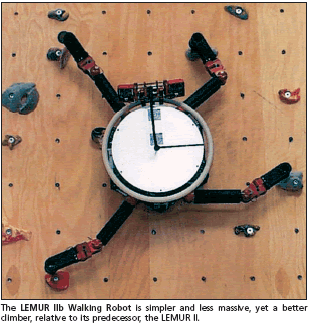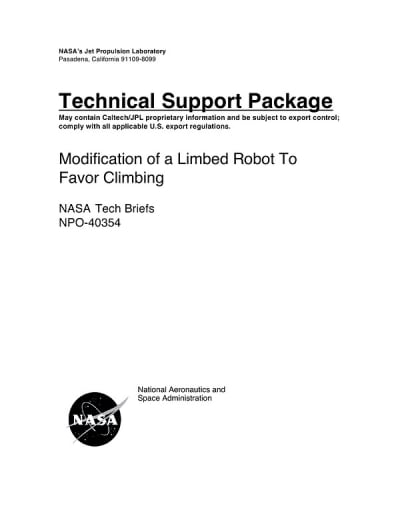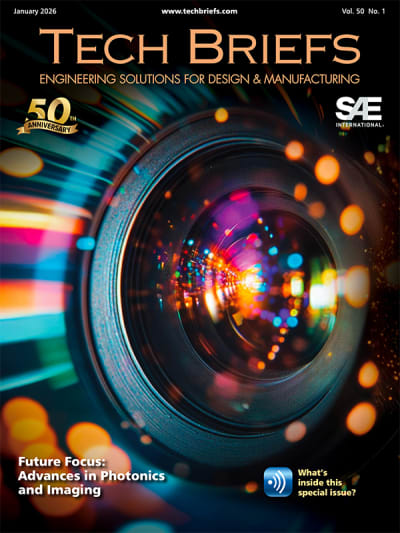The figure shows the LEMUR IIb, which is a modified version of the LEMUR II — the second generation of the Limbed Excursion Mechanical Utility Robot (LEMUR). Except as described below, the LEMUR IIb hardware is mostly the same as that of the LEMUR II. The IIb and II versions differ in their kinematic configurations and characteristics associated with their kinematic configurations. The differences are such that relative to the LEMUR II, the LEMUR IIb is simpler and is better suited to climbing on inclined surfaces.
 The first-generation LEMUR, now denoted the LEMUR I, was described in "Six-Legged Experimental Robot" (NPO-20897), NASA Tech Briefs, Vol. 25, No. 12 (December 2001), page 58. The LEMUR II was described in "Second-Generation Six-Limbed Experimental Robot" (NPO-35140) NASA Tech Briefs, Vol. 28, No. 11 (November 2004), page 55. To recapitulate: the LEMUR I and LEMUR II were six-legged or six-limbed robots for demonstrating robotic capabilities for assembly, maintenance, and inspection. They were designed to be capable of walking autonomously along a truss structure toward a mechanical assembly at a prescribed location. They were equipped with stereoscopic video cameras and image-data-processing circuitry for navigation and mechanical operations. They were also equipped with wireless modems, through which they could be commanded remotely. Upon arrival at a mechanical assembly, the LEMUR I would perform simple mechanical operations by use of one or both of its front legs (or in the case of the LEMUR II, any of its limbs could be used to perform mechanical operations). Either LEMUR could also transmit images to a host computer. The differences between the LEMUR IIb and the LEMUR II are the following:
The first-generation LEMUR, now denoted the LEMUR I, was described in "Six-Legged Experimental Robot" (NPO-20897), NASA Tech Briefs, Vol. 25, No. 12 (December 2001), page 58. The LEMUR II was described in "Second-Generation Six-Limbed Experimental Robot" (NPO-35140) NASA Tech Briefs, Vol. 28, No. 11 (November 2004), page 55. To recapitulate: the LEMUR I and LEMUR II were six-legged or six-limbed robots for demonstrating robotic capabilities for assembly, maintenance, and inspection. They were designed to be capable of walking autonomously along a truss structure toward a mechanical assembly at a prescribed location. They were equipped with stereoscopic video cameras and image-data-processing circuitry for navigation and mechanical operations. They were also equipped with wireless modems, through which they could be commanded remotely. Upon arrival at a mechanical assembly, the LEMUR I would perform simple mechanical operations by use of one or both of its front legs (or in the case of the LEMUR II, any of its limbs could be used to perform mechanical operations). Either LEMUR could also transmit images to a host computer. The differences between the LEMUR IIb and the LEMUR II are the following:
- Whereas the LEMUR II had six limbs, the LEMUR IIb has four limbs. This change has reduced both the complexity and mass of the legs and of the overall robot.
- Whereas each limb of the LEMUR II had four degrees of freedom (DOFs), each limb of the LEMUR IIb has three DOFs. This change has also reduced both complexity and mass. Notwithstanding the decrease in the number of DOFs, the three remaining DOFs are configured to provide greater dexterity for motion along a surface.
- To extend reach, the limbs of the LEMUR IIb are 25 percent longer than those of the LEMUR II.
- Additional benefits stemming from the modifications are that the robot body supported by the limbs is now less massive and its center of gravity is now closer to the surface along which the robot is to move.
These benefits have been obtained without sacrificing load-carrying capacity. Hence, overall, the LEMUR IIb is a more adept climber.
This work was done by Avi Okon, Brett Kennedy, Michael Garrett, and Lee Magnone of Caltech for NASA's Jet Propulsion Laboratory. For further information, access the Technical Support Package (TSP) free on-line at www.techbriefs.com/tsp under the Machinery/Automation category. NPO-40354
This Brief includes a Technical Support Package (TSP).

Modification of a Limbed Robot To Favor Climbing
(reference NPO-40354) is currently available for download from the TSP library.
Don't have an account?
Overview
The document is a Technical Support Package from NASA's Jet Propulsion Laboratory (JPL) concerning the modification of a limbed robot to enhance its climbing capabilities, referenced as NPO-40354 in NASA Tech Briefs. It is part of the Commercial Technology Program, which aims to disseminate aerospace-related developments that have potential applications beyond their original context.
The document outlines the technical aspects and modifications made to the limbed robot, focusing on its design and functionality to improve climbing performance. While specific details about the modifications are not provided in the pages, the emphasis is on the robot's adaptability and efficiency in navigating vertical surfaces, which is crucial for various applications, including exploration in challenging terrains.
The Technical Support Package also serves as a resource for those interested in the broader implications of this technology. It highlights the potential for commercial and scientific applications, suggesting that the advancements in robotic climbing capabilities could benefit industries such as construction, search and rescue, and planetary exploration.
Additionally, the document includes information about compliance with U.S. export regulations, indicating that the content may contain proprietary information from Caltech/JPL. It stresses the importance of adhering to these regulations when utilizing the information provided.
For further assistance and information, the document directs readers to the NASA Scientific and Technical Information (STI) Program Office, providing contact details for inquiries. This includes a website link and contact information for the NASA STI Help Desk, which can assist with accessing additional publications and resources related to aerospace research and technology.
Overall, the Technical Support Package encapsulates the innovative efforts of NASA in advancing robotic technology, particularly in enhancing the climbing abilities of limbed robots, while also promoting collaboration and knowledge sharing within the scientific and commercial sectors. The document serves as a gateway for further exploration into the applications of this technology and its potential impact on various fields.

